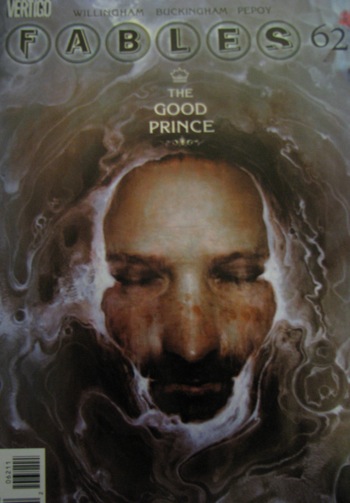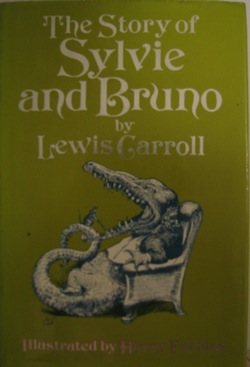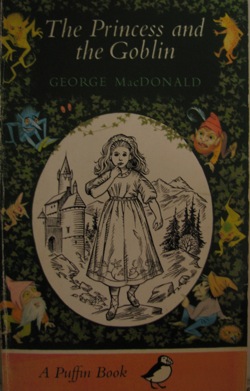Every time I look at the bookshelves in the living room, I wonder whether or not I should arrange them so that the most intellectually impressive books are in there (why, yes, I am secretly pretentious) or, at least, the books that I read most often.
But, then, I suspect that the Magical Mystery Bookshelf Tour has, if nothing else, revealed the fact that my bookshelves have absolutely no organising principle behind them, at all.
But I do have a reason for showing the top shelf of this bookcase:

A reason apart from the fact that it shows a number of books, that is.
I feel my poor little donkey, over there on the far right, deserves his own picture on the blog. Yes, his legs are actually kept on with packing tape. I bought him twenty-two years ago (well, at that age, I had him bought for me by my parents) in a shop in Jerusalem: he’s made of olive wood. He’s lovely—a little naive in style, perhaps, but a lovely donkey. But his legs are highly fragile: they’ve been glued back on more times than I can remember. Eventually, I just gave up: hence the packing tape. One day, I fully intend to actually take that tape off and glue his legs back on. Again.
In the interim, I think he deserves a small degree of Internet celebrity.
What? Oh, the actual books.
This top shelf, actually, is a straightforward mix of the absolutely essential (Douglas Adams); the unread and occasionally embarrassing, if seminal (Brian Aldiss); Nick’s books, which he keep bullying me to read, but I never seem to get around to it (Steven Brust); and the fascinating series that I started and enjoyed, but gave up because I became inappropriately fond of the brainwashed rapist, could see his eventual fate coming, and didn’t really think I could face it (Lois McMaster Bujold).
That last category is, I grant you, rather specific.
Ooh, speaking of books that are seminal and yet rather embarrassing since I’ve never actually read them:

There’s C. J. Cherryh! My sister is something of a devotee of Cherryh’s work, and I myself have to admire the the fact that she became irritated with the way in which her strong heroines were always depicted on the covers in gold bikinis, and wrote a series about giant cat people as a way of saying, “Right. Stick that in a gold bikini.”
(I bet there’s an edition of the Chanur series somewhere where the characters are depicted in gold bikinis.)
But I find her books incomprehensible. And I say that in an admiring way: she throws the reader in the deep end of an entirely fictitious world, complete with plausibly alien language patterns, and you have to struggle to the surface before you can even figure out the plot.
Well, I’m not a good swimmer, apparently.
(How was that metaphor? Too tortured? Also, don’t tell the people whom I want to award me a Ph.D. in English Literature what I just said. Okay?)
At least, I can’t seem to stick with the books long enough to slip into their mode of thinking. But I want to, so I keep buying them. Hence the huge number of unread, secondhand paperbacks on that shelf.
Actually, speaking of just plain embarrassing, there are some Michael Crichton books.
Can I get away with blaming those on Nick? Nope, didn’t think so. They definitely shouldn’t be out in plain sight. (Though, I have to say, the Jurassic Park ones are miles better than the movies, especially in terms of strong female characters.)
I do like those Diane Duane young adult books, though: the So You Want To Be A Wizard series. Unfortunately, Duane suffers from similar-name syndrome, probably because she writes Star Trek novelisations, and so does Diane Carey, whose work is not nearly as good.
Another example of similar-name syndrome is Elizabeth Moon (good) as opposed to Elizabeth Lynn (not so good). There’s another example, but I’ve forgotten it. And Nick’s not helping:
ME: Can you think of that other example of authors with similar-name syndrome? I’ve forgotten.
NICK: Male or female?
ME: I’ve forgotten!
The Philip Jose Farmer books are others that I haven’t read in years, and may never read again. I’m keeping them, though, because the concept of the Riverworld fascinates me. As far as I can remember, though, they went a bit pear-shaped at the end. Maybe there were dinosaurs? And Hitler showed up at one point, I seem to remember. Odd. But clever world-building.
In my defense, I should point out that the Laurell K. Hamilton books actually are Nick’s. No, seriously: I’m not trying to blame him for something embarrassing that’s actually mine. I have read most of those, though: I think I gave up before Obsidian Butterfly. We both gave up: they started shakily, with an interesting premise but a tendency to info-dump in a frustrating fashion, then steadied up for a little while, then took an entirely unexpected (unexpected by me, anyway) turn into out-and-out porn. At least the Merry Gentry books started out as porn.
Still, at least there’s nothing to be ashamed about with Ursula K. Le Guin.

I think I’ve mentioned before how much I enjoy Garth Nix’s books, perhaps during the spare-room portion of the tour, which is where my copies of the Keys to the Kingdom series are.
And then we just slide straight into Terry Pratchett, and there’s not much I can say about him that I didn’t cover in my post about how much I hope to grow up to be Granny Weatherwax.
The next shelf, though, is almost al Nick’s, including the E. E. ‘Doc’ Smith (already canvassed over at Smithology more comprehensively than I could manage here), the S. P. Somtow, and the Vernor Vinge.
Those are my Patricia C. Wrede’s Enchanted Forest Chronicles, though. Ah, Cimmorene: you were a proper princess, but I never did figure out how you worked out the age imbalance at the end of the last book. (How’s not for an entirely obscure non-spoiler?)
I also loved Sorcery and Cecelia or The Enchanted Chocolate Pot: Being the Correspondence of Two Young Ladies of Quality Regarding Various Magical Scandals in London and the Country (now that’s a good title), which she wrote turn and turn about with Caroline Stevermer (whose A College of Magics I have somewhere, but, surprisingly, haven’t read yet.)
That reminds me: I have the sequel to Sorcery and Cecilia—I must (no, you know how this goes) get around to reading that.
And then there’s nothing left but Diana Wynne Jones:

Well, Diana Wynne Jones and Phillip Pullman. I had a (friendly and intellectual) disagreement with my sister about these. She felt that the His Dark Materials trilogy was anti-humanist, if I haven’t misrepresented her: that, essentially, he didn’t seem to like people. Similarly, she couldn’t read further than The Ruby in the Smoke in the Sally Lockheart series, because she disliked the way in which he constantly tore down and devastated the heroine.
Now, I’m not going to touch the argument about His Dark Materials, but I can’t say that I entirely disagree with the one about Sally Lockheart.
And yet, to a certain degree, that’s why I liked them. True, I had to stop reading halfway through The Tiger in the Well because my entire body was crunched up into an agonising ball at the thought of what horrible thing could happen next.
But isn’t that something extraordinary?
I read. I read an enormous amount. And few of the books I read inspire that sort of visceral response (though that may have something to do with the books that I select).
Basically, I’d sum the Sally Lockheart Mysteries up this way:
I’ve spent three years reading and researching penny-weekly serials. And most penny-weekly serials are bad.
Awesome, yes. But bad. Because they’re written under enormous time constraints for little remuneration.
Even when they’re doing something intriguing with the conventions of the form, they’re often bad: verbose, implausible, and silly.
The Sally Lockheart Mysteries are penny-weekly serials (not penny dreadfuls: chronologically, they take place between the great days of the penny dreadfuls and the late, boys’-own-adventure-style penny bloods) written by someone who can actually write.
And when that happens, you can’t giggle at the travails of the heroine, once again kidnapped by her own father who doesn’t know who she is and has already failed (twice) to seduce her. (This doesn’t happen in any Pullman novel, but does happen in Eliza Winstanley’s “The Strollers.”)
When that happens, you’re forced into accepting that the heroine’s travails are terrifying.
That doesn’t mean they’re easy to read, though.
On a lighter note, those tiny little figures on the shelves are, in fact, Warhammer figurines.
That’s really just an excuse to exploit the macro function on my camera again.


No shelf is complete with dwarfs wielding fearsome weapons.









































